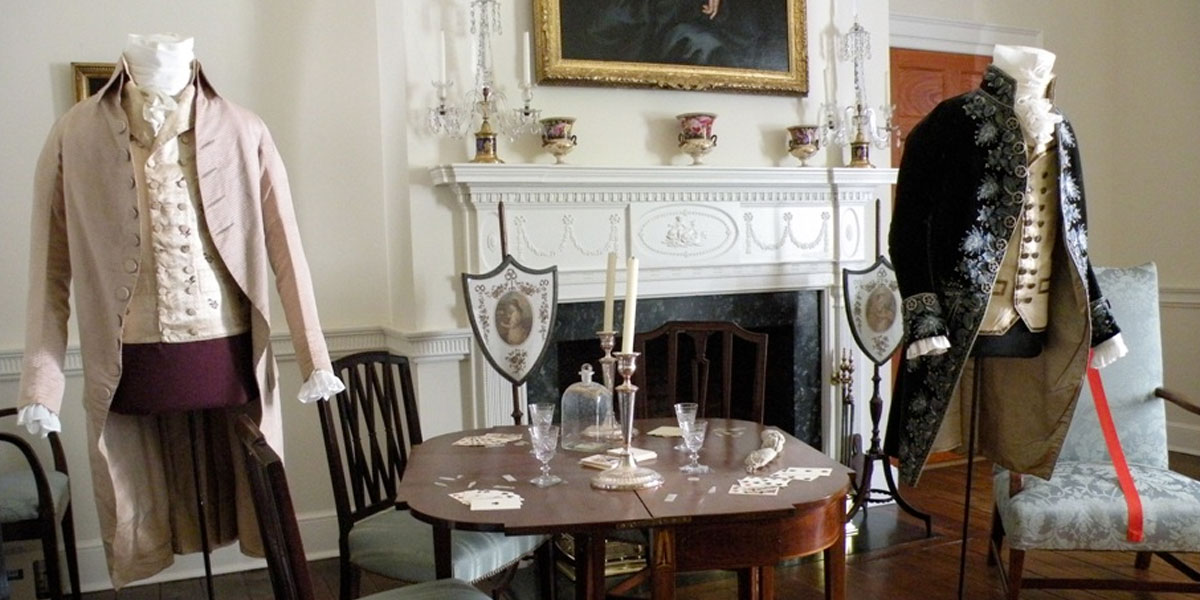As the United States of America forged its own national identity, festive balls were held to express the population’s optimism and confidence. The ball, a party with music and dancing, gained in popularity as the country’s strength and assurance grew. One of the most popular was the Birth-Night Ball, an annual celebration of George Washington’s birth, held around February 22nd.
Although a ball was held a week after George Washington’s inauguration to celebrate his election to the presidency in 1789, the first official Inaugural Ball did not take place until 1809, during President James Madison’s first term. The tradition of Inaugural Balls continues to the present. It is important to remember that the introduction of these balls reflected a sense of national pride with in America that was not limited to inaugural events.
Preparing for the Ball: Costume of the Early Nation presents attire worn both before and during the ball. Period clothing provides a personalized context that illuminates the experience of domestic life. Through this exhibition, one will gain insight into daily life 200 years ago as one was Preparing for the Ball.
Clothing for the Women
Women’s fashions in the late 1700s transitioned from the formality of voluminous hoop-supported gowns and petticoats to slim, neoclassically inspired, high-waisted silhouettes. These new styles necessitated updated foundation garments with more flexible cotton and linen, rather than the stiff, heavily boned stays (corsets) worn earlier in the century.


Courtesy of Dumbarton House/The National Society of The Colonial Dames of America. 



Developments in textile printing technology enabled consumers to acquire stylish linen and cotton garments that were considerably less expensive than hand-woven, elaborately patterned silks—the hallmarks of eighteenth-century elegance. Printed fabric designs were made using copper plates and woodblocks, producing diverse monochromatic and multicolored patterns. Roller printing, invented in the 1780s, and later developments in mechanized weaving and printing became the backbone of nineteenth century Industrial Revolution technology. The reduced cost of textiles produced by these methods facilitated a democratization of fashion, though all clothing was still handmade either at home or by professional dressmakers.
The high-waisted white muslin dresses worn by many fashionable women in the early 1800s were a sign of the current egalitarian spirit in artistic and political philosophy. Although simple in design, these garments reflected an increased precision in dressmaking techniques. Contemporary political and military events exerted a strong influence on decorative details, such the lacing borrowed from men’s military uniforms. High-waisted fashions remained in vogue until the 1820s.
Clothing for the Gentlemen
In the 1700s, a man’s suit consisted of a coat, waistcoat, and breeches, under which he wore a linen shirt. All clothing was created by hand, and men’s suits were produced by trained tailors using an impressive variety of fabrics. Traditionally, the coat and breeches were made of the same fabric, but coordinating fabrics were also worn together. The quality and expense of these textiles defined the public image and social class of their owners.
By the early 1800s, the exaggerated cutaway shape of late eighteenth-century men’s coats had developed into the double-breasted frock coat. Fashionable gentlemen cultivated a fastidious appearance with an increased emphasis on neatness and personal hygiene. High-collared shirts and their elaborately tied cravats were frequently laundered and changed, creating a polished appearance that replaced the decorative extravagance of earlier attire. Elements from military and equestrian clothing were also frequently modified for men’s fashionable day wear. In particular, trousers, which evolved from the calf-length pants worn for riding, replaced knee breeches.
The nineteenth-century preference for wool suiting over elaborately embroidered or decorative silks conveyed a growing professional sobriety appropriate for commercial centers such as Georgetown and the developing Federal City of Washington. These dark wool suits were the precursors of the standard male business attire worn today.
Clothing the Child
The evolution of children’s clothing reflects changes in philosophical and cultural attitudes towards childhood. Prior to the late 1700s, children were regarded as miniature but defective adults, with few concessions made to their youth and immaturity. Indeed, it was accepted that children needed strict discipline and physical reinforcement in order to be socially tamed.
From infancy, boys and girls were similarly attired in frocks or dresses. Then, at age five or six, children began to be dressed as miniature adults. For young boys, this passage from androgynous frocks into suits with breeches was an important milestone in their development.
In 1762 Jean-Jacques Rousseau’s revolutionary treatise, Emile, ou de l’education, encouraged more enlightened attitudes toward childrearing, resulting in clothing specifically designed for young children. Around 1780, the “skeleton suit,” a garment designed exclusively for young boys, made its appearance. Skeleton suits had ankle-length trousers that buttoned onto a form-fitting jacket worn over a soft lawn shirt.
Young girls wore white cotton frocks adorned with broad sashes that foreshadowed the progression of adult female fashions to similar styles with elevated waistlines and looser fit. In the early 1800s, long, white cotton trousers known as pantalettes or underdrawers were first worn by young girls. Pantalettes peeked out from under shortened dresses so that their ankle-length hems were visible. Women would adopt these protective and hygienic garments in the 1820s and 1830s.

















